Haofei Zhang
Reinforced Model Merging
Mar 27, 2025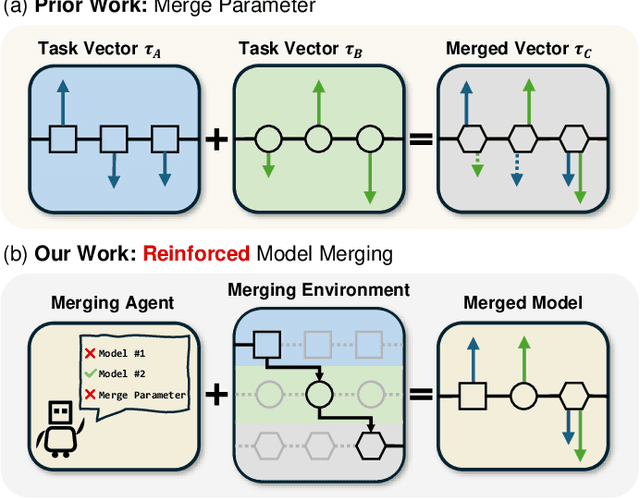
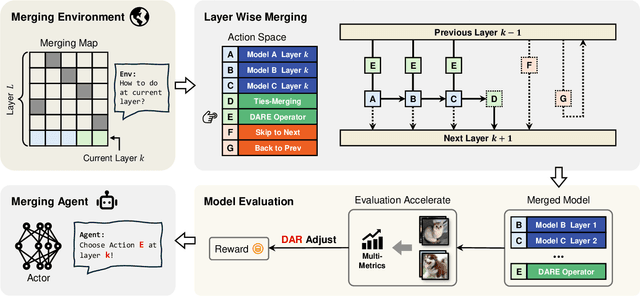
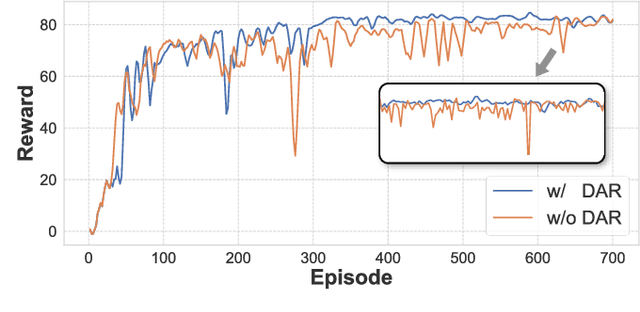

Abstract:The success of large language models has garnered widespread attention for model merging techniques, especially training-free methods which combine model capabilities within the parameter space. However, two challenges remain: (1) uniform treatment of all parameters leads to performance degradation; (2) search-based algorithms are often inefficient. In this paper, we present an innovative framework termed Reinforced Model Merging (RMM), which encompasses an environment and agent tailored for merging tasks. These components interact to execute layer-wise merging actions, aiming to search the optimal merging architecture. Notably, RMM operates without any gradient computations on the original models, rendering it feasible for edge devices. Furthermore, by utilizing data subsets during the evaluation process, we addressed the bottleneck in the reward feedback phase, thereby accelerating RMM by up to 100 times. Extensive experiments demonstrate that RMM achieves state-of-the-art performance across various vision and NLP datasets and effectively overcomes the limitations of the existing baseline methods. Our code is available at https://github.com/WuDiHJQ/Reinforced-Model-Merging.
Dataset Ownership Verification in Contrastive Pre-trained Models
Feb 11, 2025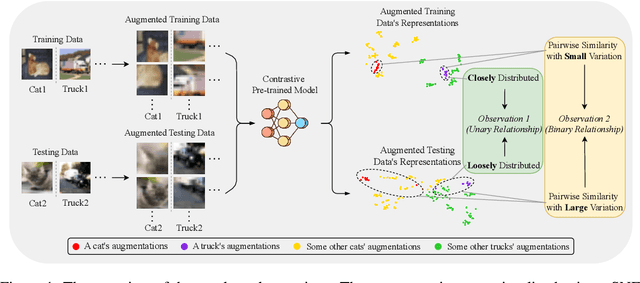
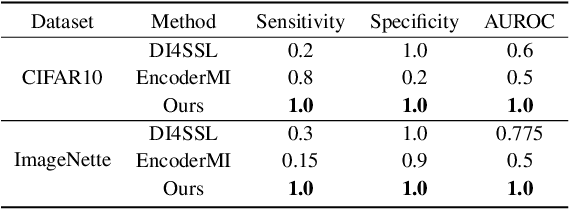
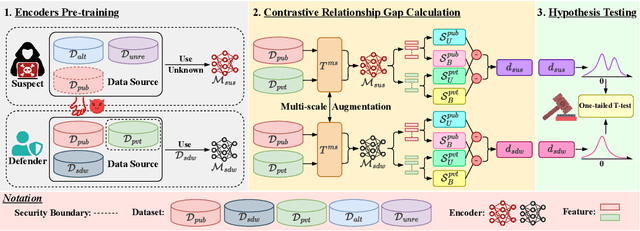
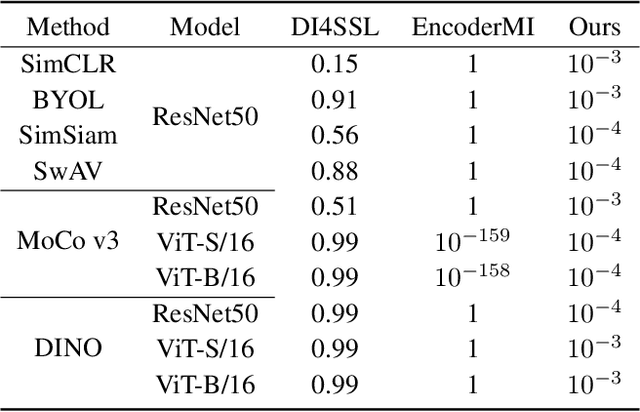
Abstract:High-quality open-source datasets, which necessitate substantial efforts for curation, has become the primary catalyst for the swift progress of deep learning. Concurrently, protecting these datasets is paramount for the well-being of the data owner. Dataset ownership verification emerges as a crucial method in this domain, but existing approaches are often limited to supervised models and cannot be directly extended to increasingly popular unsupervised pre-trained models. In this work, we propose the first dataset ownership verification method tailored specifically for self-supervised pre-trained models by contrastive learning. Its primary objective is to ascertain whether a suspicious black-box backbone has been pre-trained on a specific unlabeled dataset, aiding dataset owners in upholding their rights. The proposed approach is motivated by our empirical insights that when models are trained with the target dataset, the unary and binary instance relationships within the embedding space exhibit significant variations compared to models trained without the target dataset. We validate the efficacy of this approach across multiple contrastive pre-trained models including SimCLR, BYOL, SimSiam, MOCO v3, and DINO. The results demonstrate that our method rejects the null hypothesis with a $p$-value markedly below $0.05$, surpassing all previous methodologies. Our code is available at https://github.com/xieyc99/DOV4CL.
LG-CAV: Train Any Concept Activation Vector with Language Guidance
Oct 14, 2024



Abstract:Concept activation vector (CAV) has attracted broad research interest in explainable AI, by elegantly attributing model predictions to specific concepts. However, the training of CAV often necessitates a large number of high-quality images, which are expensive to curate and thus limited to a predefined set of concepts. To address this issue, we propose Language-Guided CAV (LG-CAV) to harness the abundant concept knowledge within the certain pre-trained vision-language models (e.g., CLIP). This method allows training any CAV without labeled data, by utilizing the corresponding concept descriptions as guidance. To bridge the gap between vision-language model and the target model, we calculate the activation values of concept descriptions on a common pool of images (probe images) with vision-language model and utilize them as language guidance to train the LG-CAV. Furthermore, after training high-quality LG-CAVs related to all the predicted classes in the target model, we propose the activation sample reweighting (ASR), serving as a model correction technique, to improve the performance of the target model in return. Experiments on four datasets across nine architectures demonstrate that LG-CAV achieves significantly superior quality to previous CAV methods given any concept, and our model correction method achieves state-of-the-art performance compared to existing concept-based methods. Our code is available at https://github.com/hqhQAQ/LG-CAV.
On the Evaluation Consistency of Attribution-based Explanations
Jul 28, 2024
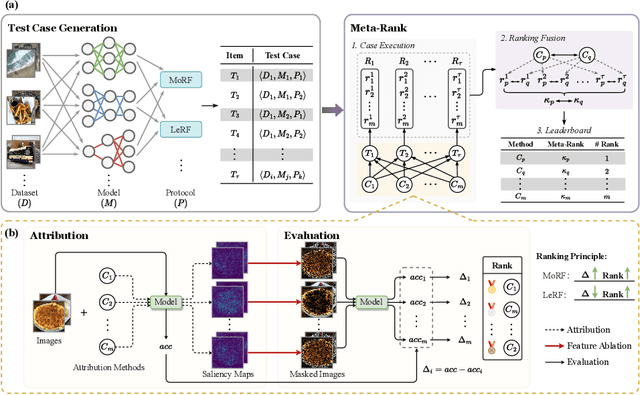
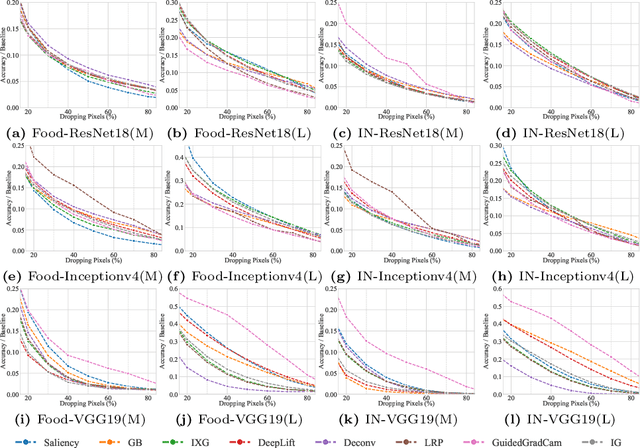

Abstract:Attribution-based explanations are garnering increasing attention recently and have emerged as the predominant approach towards \textit{eXplanable Artificial Intelligence}~(XAI). However, the absence of consistent configurations and systematic investigations in prior literature impedes comprehensive evaluations of existing methodologies. In this work, we introduce {Meta-Rank}, an open platform for benchmarking attribution methods in the image domain. Presently, Meta-Rank assesses eight exemplary attribution methods using six renowned model architectures on four diverse datasets, employing both the \textit{Most Relevant First} (MoRF) and \textit{Least Relevant First} (LeRF) evaluation protocols. Through extensive experimentation, our benchmark reveals three insights in attribution evaluation endeavors: 1) evaluating attribution methods under disparate settings can yield divergent performance rankings; 2) although inconsistent across numerous cases, the performance rankings exhibit remarkable consistency across distinct checkpoints along the same training trajectory; 3) prior attempts at consistent evaluation fare no better than baselines when extended to more heterogeneous models and datasets. Our findings underscore the necessity for future research in this domain to conduct rigorous evaluations encompassing a broader range of models and datasets, and to reassess the assumptions underlying the empirical success of different attribution methods. Our code is publicly available at \url{https://github.com/TreeThree-R/Meta-Rank}.
Enhancing Thermal Infrared Tracking with Natural Language Modeling and Coordinate Sequence Generation
Jul 11, 2024



Abstract:Thermal infrared tracking is an essential topic in computer vision tasks because of its advantage of all-weather imaging. However, most conventional methods utilize only hand-crafted features, while deep learning-based correlation filtering methods are limited by simple correlation operations. Transformer-based methods ignore temporal and coordinate information, which is critical for TIR tracking that lacks texture and color information. In this paper, to address these issues, we apply natural language modeling to TIR tracking and propose a novel model called NLMTrack, which enhances the utilization of coordinate and temporal information. NLMTrack applies an encoder that unifies feature extraction and feature fusion, which simplifies the TIR tracking pipeline. To address the challenge of low detail and low contrast in TIR images, on the one hand, we design a multi-level progressive fusion module that enhances the semantic representation and incorporates multi-scale features. On the other hand, the decoder combines the TIR features and the coordinate sequence features using a causal transformer to generate the target sequence step by step. Moreover, we explore an adaptive loss aimed at elevating tracking accuracy and a simple template update strategy to accommodate the target's appearance variations. Experiments show that NLMTrack achieves state-of-the-art performance on multiple benchmarks. The Code is publicly available at \url{https://github.com/ELOESZHANG/NLMTrack}.
On the Concept Trustworthiness in Concept Bottleneck Models
Mar 21, 2024



Abstract:Concept Bottleneck Models (CBMs), which break down the reasoning process into the input-to-concept mapping and the concept-to-label prediction, have garnered significant attention due to their remarkable interpretability achieved by the interpretable concept bottleneck. However, despite the transparency of the concept-to-label prediction, the mapping from the input to the intermediate concept remains a black box, giving rise to concerns about the trustworthiness of the learned concepts (i.e., these concepts may be predicted based on spurious cues). The issue of concept untrustworthiness greatly hampers the interpretability of CBMs, thereby hindering their further advancement. To conduct a comprehensive analysis on this issue, in this study we establish a benchmark to assess the trustworthiness of concepts in CBMs. A pioneering metric, referred to as concept trustworthiness score, is proposed to gauge whether the concepts are derived from relevant regions. Additionally, an enhanced CBM is introduced, enabling concept predictions to be made specifically from distinct parts of the feature map, thereby facilitating the exploration of their related regions. Besides, we introduce three modules, namely the cross-layer alignment (CLA) module, the cross-image alignment (CIA) module, and the prediction alignment (PA) module, to further enhance the concept trustworthiness within the elaborated CBM. The experiments on five datasets across ten architectures demonstrate that without using any concept localization annotations during training, our model improves the concept trustworthiness by a large margin, meanwhile achieving superior accuracy to the state-of-the-arts. Our code is available at https://github.com/hqhQAQ/ProtoCBM.
Angle Robustness Unmanned Aerial Vehicle Navigation in GNSS-Denied Scenarios
Feb 04, 2024



Abstract:Due to the inability to receive signals from the Global Navigation Satellite System (GNSS) in extreme conditions, achieving accurate and robust navigation for Unmanned Aerial Vehicles (UAVs) is a challenging task. Recently emerged, vision-based navigation has been a promising and feasible alternative to GNSS-based navigation. However, existing vision-based techniques are inadequate in addressing flight deviation caused by environmental disturbances and inaccurate position predictions in practical settings. In this paper, we present a novel angle robustness navigation paradigm to deal with flight deviation in point-to-point navigation tasks. Additionally, we propose a model that includes the Adaptive Feature Enhance Module, Cross-knowledge Attention-guided Module and Robust Task-oriented Head Module to accurately predict direction angles for high-precision navigation. To evaluate the vision-based navigation methods, we collect a new dataset termed as UAV_AR368. Furthermore, we design the Simulation Flight Testing Instrument (SFTI) using Google Earth to simulate different flight environments, thereby reducing the expenses associated with real flight testing. Experiment results demonstrate that the proposed model outperforms the state-of-the-art by achieving improvements of 26.0% and 45.6% in the success rate of arrival under ideal and disturbed circumstances, respectively.
Improving Expressivity of GNNs with Subgraph-specific Factor Embedded Normalization
Jun 11, 2023



Abstract:Graph Neural Networks (GNNs) have emerged as a powerful category of learning architecture for handling graph-structured data. However, existing GNNs typically ignore crucial structural characteristics in node-induced subgraphs, which thus limits their expressiveness for various downstream tasks. In this paper, we strive to strengthen the representative capabilities of GNNs by devising a dedicated plug-and-play normalization scheme, termed as SUbgraph-sPEcific FactoR Embedded Normalization (SuperNorm), that explicitly considers the intra-connection information within each node-induced subgraph. To this end, we embed the subgraph-specific factor at the beginning and the end of the standard BatchNorm, as well as incorporate graph instance-specific statistics for improved distinguishable capabilities. In the meantime, we provide theoretical analysis to support that, with the elaborated SuperNorm, an arbitrary GNN is at least as powerful as the 1-WL test in distinguishing non-isomorphism graphs. Furthermore, the proposed SuperNorm scheme is also demonstrated to alleviate the over-smoothing phenomenon. Experimental results related to predictions of graph, node, and link properties on the eight popular datasets demonstrate the effectiveness of the proposed method. The code is available at https://github.com/chenchkx/SuperNorm.
Message-passing selection: Towards interpretable GNNs for graph classification
Jun 08, 2023Abstract:In this paper, we strive to develop an interpretable GNNs' inference paradigm, termed MSInterpreter, which can serve as a plug-and-play scheme readily applicable to various GNNs' baselines. Unlike the most existing explanation methods, MSInterpreter provides a Message-passing Selection scheme(MSScheme) to select the critical paths for GNNs' message aggregations, which aims at reaching the self-explaination instead of post-hoc explanations. In detail, the elaborate MSScheme is designed to calculate weight factors of message aggregation paths by considering the vanilla structure and node embedding components, where the structure base aims at weight factors among node-induced substructures; on the other hand, the node embedding base focuses on weight factors via node embeddings obtained by one-layer GNN.Finally, we demonstrate the effectiveness of our approach on graph classification benchmarks.
Generalization Matters: Loss Minima Flattening via Parameter Hybridization for Efficient Online Knowledge Distillation
Mar 26, 2023



Abstract:Most existing online knowledge distillation(OKD) techniques typically require sophisticated modules to produce diverse knowledge for improving students' generalization ability. In this paper, we strive to fully utilize multi-model settings instead of well-designed modules to achieve a distillation effect with excellent generalization performance. Generally, model generalization can be reflected in the flatness of the loss landscape. Since averaging parameters of multiple models can find flatter minima, we are inspired to extend the process to the sampled convex combinations of multi-student models in OKD. Specifically, by linearly weighting students' parameters in each training batch, we construct a Hybrid-Weight Model(HWM) to represent the parameters surrounding involved students. The supervision loss of HWM can estimate the landscape's curvature of the whole region around students to measure the generalization explicitly. Hence we integrate HWM's loss into students' training and propose a novel OKD framework via parameter hybridization(OKDPH) to promote flatter minima and obtain robust solutions. Considering the redundancy of parameters could lead to the collapse of HWM, we further introduce a fusion operation to keep the high similarity of students. Compared to the state-of-the-art(SOTA) OKD methods and SOTA methods of seeking flat minima, our OKDPH achieves higher performance with fewer parameters, benefiting OKD with lightweight and robust characteristics. Our code is publicly available at https://github.com/tianlizhang/OKDPH.
 Add to Chrome
Add to Chrome Add to Firefox
Add to Firefox Add to Edge
Add to Edge